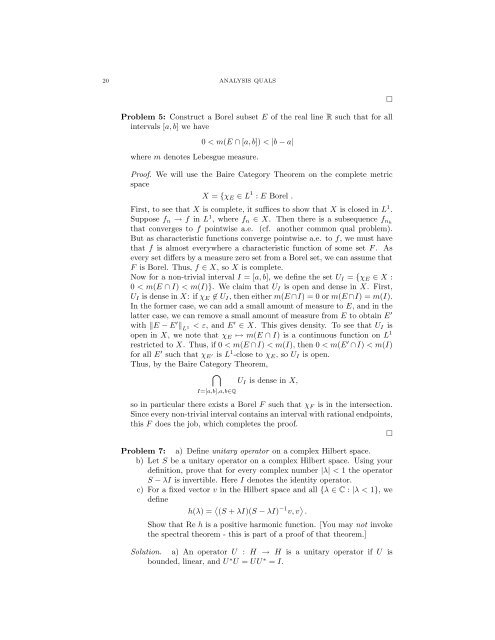ANALYSIS QUALIFYING EXAM PROBLEMS BRIAN LEARY ...
ANALYSIS QUALIFYING EXAM PROBLEMS BRIAN LEARY ...
ANALYSIS QUALIFYING EXAM PROBLEMS BRIAN LEARY ...
You also want an ePaper? Increase the reach of your titles
YUMPU automatically turns print PDFs into web optimized ePapers that Google loves.
20 <strong>ANALYSIS</strong> QUALS<br />
Problem 5: Construct a Borel subset E of the real line R such that for all<br />
intervals [a, b] we have<br />
0 < m(E ∩ [a, b]) < |b − a|<br />
where m denotes Lebesgue measure.<br />
Proof. We will use the Baire Category Theorem on the complete metric<br />
space<br />
X = {χE ∈ L 1 : E Borel .<br />
First, to see that X is complete, it suffices to show that X is closed in L1 .<br />
Suppose fn → f in L1 , where fn ∈ X. Then there is a subsequence fnk<br />
that converges to f pointwise a.e. (cf. another common qual problem).<br />
But as characteristic functions converge pointwise a.e. to f, we must have<br />
that f is almost everywhere a characteristic function of some set F . As<br />
every set differs by a measure zero set from a Borel set, we can assume that<br />
F is Borel. Thus, f ∈ X, so X is complete.<br />
Now for a non-trivial interval I = [a, b], we define the set UI = {χE ∈ X :<br />
0 < m(E ∩ I) < m(I)}. We claim that UI is open and dense in X. First,<br />
UI is dense in X: if χE ∈ UI, then either m(E ∩I) = 0 or m(E ∩I) = m(I).<br />
In the former case, we can add a small amount of measure to E, and in the<br />
latter case, we can remove a small amount of measure from E to obtain E ′<br />
with E − E ′ L1 < ε, and E ′ ∈ X. This gives density. To see that UI is<br />
open in X, we note that χE ↦→ m(E ∩ I) is a continuous function on L1 restricted to X. Thus, if 0 < m(E ∩ I) < m(I), then 0 < m(E ′ ∩ I) < m(I)<br />
for all E ′ such that χE ′ is L1-close to χE, so UI is open.<br />
Thus, by the Baire Category Theorem,<br />
<br />
UI is dense in X,<br />
I=[a,b],a,b∈Q<br />
so in particular there exists a Borel F such that χF is in the intersection.<br />
Since every non-trivial interval contains an interval with rational endpoints,<br />
this F does the job, which completes the proof.<br />
<br />
Problem 7: a) Define unitary operator on a complex Hilbert space.<br />
b) Let S be a unitary operator on a complex Hilbert space. Using your<br />
definition, prove that for every complex number |λ| < 1 the operator<br />
S − λI is invertible. Here I denotes the identity operator.<br />
c) For a fixed vector v in the Hilbert space and all {λ ∈ C : |λ < 1}, we<br />
define<br />
h(λ) = (S + λI)(S − λI) −1 v, v .<br />
Show that Re h is a positive harmonic function. [You may not invoke<br />
the spectral theorem - this is part of a proof of that theorem.]<br />
Solution. a) An operator U : H → H is a unitary operator if U is<br />
bounded, linear, and U ∗ U = UU ∗ = I.
















